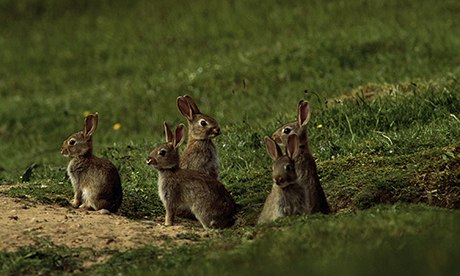A sense of mythical nostalgia makes this story – of a treacherous journey and quest for survival – one to pick up, time and time again

Beyond anthropomorphism … Adams' rabbits tell a story of loyalty and perseverence. Photograph: Neil Mcintyre/Getty Images
Watership Down, Richard Adams' first novel, made its way into my life in the Christmas of 1974 and has drawn me back to its yellowing pages ever since. A present from a much loved uncle, the story of the quest for survival by a brave, easy to love band of rabbits, seemed to combine the intimacy of a myth with the scale of a battle. For me it continues to hold the lure and the comfort of a pilgrimage to be made and remade.
 "The primroses were over:" the seasonal melancholy of the first line runs as a thread through the text, its sad beauty drawing us in. From the beginning, the fact of seeing of the world and the initial surroundings of Sandleford Warren through the eyes of the rabbits is something which, as readers, we don't question. So immersed are we in their vantage point that the appearance in the closing chapters of a human in the shape of Lucy, the farm girl at Nuthanger, comes as something of a reversal. Adams has sometimes been said to have "anthropomorphised" the rabbits but it always seemed to me that their charm was rather that we become them.The words on a new noticeboard fill the sensitive seer rabbit, Fiver, with a sense of "some terrible thing – coming closer and closer", threatening their beloved Sandleford: "the field's full of blood". Fiver's warning is ignored by the chief rabbit, forcing a small brave group – of those convinced that the warren's days are numbered – to leave, in search of a new home. Thus begins the journey at the novel's heart.
"The primroses were over:" the seasonal melancholy of the first line runs as a thread through the text, its sad beauty drawing us in. From the beginning, the fact of seeing of the world and the initial surroundings of Sandleford Warren through the eyes of the rabbits is something which, as readers, we don't question. So immersed are we in their vantage point that the appearance in the closing chapters of a human in the shape of Lucy, the farm girl at Nuthanger, comes as something of a reversal. Adams has sometimes been said to have "anthropomorphised" the rabbits but it always seemed to me that their charm was rather that we become them.The words on a new noticeboard fill the sensitive seer rabbit, Fiver, with a sense of "some terrible thing – coming closer and closer", threatening their beloved Sandleford: "the field's full of blood". Fiver's warning is ignored by the chief rabbit, forcing a small brave group – of those convinced that the warren's days are numbered – to leave, in search of a new home. Thus begins the journey at the novel's heart.
More
 "The primroses were over:" the seasonal melancholy of the first line runs as a thread through the text, its sad beauty drawing us in. From the beginning, the fact of seeing of the world and the initial surroundings of Sandleford Warren through the eyes of the rabbits is something which, as readers, we don't question. So immersed are we in their vantage point that the appearance in the closing chapters of a human in the shape of Lucy, the farm girl at Nuthanger, comes as something of a reversal. Adams has sometimes been said to have "anthropomorphised" the rabbits but it always seemed to me that their charm was rather that we become them.The words on a new noticeboard fill the sensitive seer rabbit, Fiver, with a sense of "some terrible thing – coming closer and closer", threatening their beloved Sandleford: "the field's full of blood". Fiver's warning is ignored by the chief rabbit, forcing a small brave group – of those convinced that the warren's days are numbered – to leave, in search of a new home. Thus begins the journey at the novel's heart.
"The primroses were over:" the seasonal melancholy of the first line runs as a thread through the text, its sad beauty drawing us in. From the beginning, the fact of seeing of the world and the initial surroundings of Sandleford Warren through the eyes of the rabbits is something which, as readers, we don't question. So immersed are we in their vantage point that the appearance in the closing chapters of a human in the shape of Lucy, the farm girl at Nuthanger, comes as something of a reversal. Adams has sometimes been said to have "anthropomorphised" the rabbits but it always seemed to me that their charm was rather that we become them.The words on a new noticeboard fill the sensitive seer rabbit, Fiver, with a sense of "some terrible thing – coming closer and closer", threatening their beloved Sandleford: "the field's full of blood". Fiver's warning is ignored by the chief rabbit, forcing a small brave group – of those convinced that the warren's days are numbered – to leave, in search of a new home. Thus begins the journey at the novel's heart.More
No comments:
Post a Comment